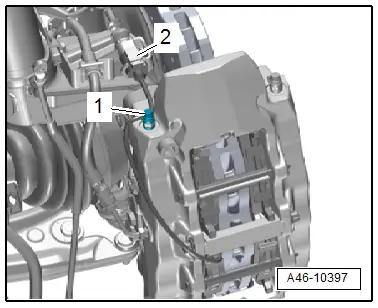Audi Q3: Front Brake Pads, Removing and Installing
Brake Pads, Removing and Installing, 1LJ, 1ZD Brakes
If old brake pads are being replaced with new ones, then it is necessary to check the brake rotor thickness for wear. Pay attention to the wear specifications for the brake rotor.
Special tools and workshop equipment required
- Torque Wrench 1331 5-50Nm -VAG1331-
- Piston Resetting Tool -T10145-
- Lithium grease
Removing
 Note
Note
When removing, mark brake pads that will be used again. Install in the same position, otherwise braking effect will be uneven.
- Remove the affected front wheel, refer to → Suspension, Wheels, Steering; Rep. Gr.44; Wheels and Tires.
- Using screwdriver, pry off brake pad retaining spring from brake caliper -arrow- and remove.
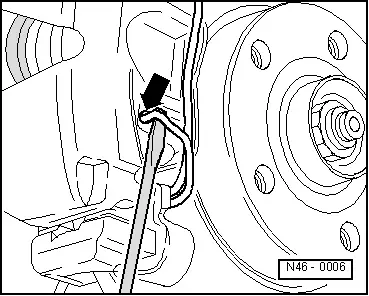
- Disconnect the connector -1- from the brake pad wear indicator.
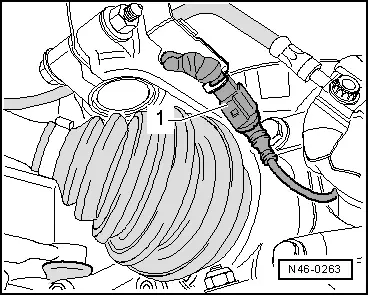
- Remove caps -arrows-.
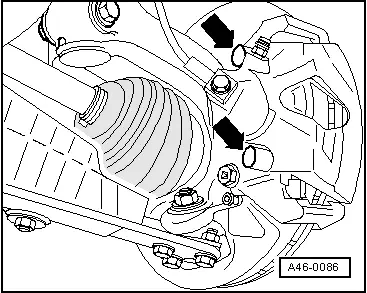
- Remove both guide pins -arrows- and remove the brake caliper.
 Caution
Caution
- Do not let the brake caliper with the brake carrier hang on the brake hose. Do not support the weight with the brake hose.
- Replace the brake hose if damaged.
- Do not press the brake pedal when the caliper is removed.
- Hang the brake caliper on the body using a suitable wire.
- Remove the brake pad from the brake caliper or from the brake carrier.
- Check the wear specification of the brake rotors, refer to → Chapter "Brakes Technical Data".
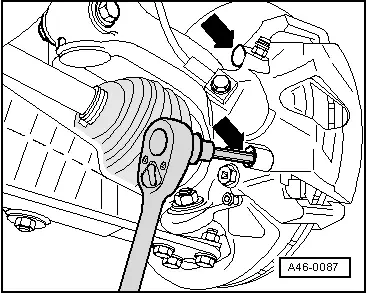
Installing
If old brake pads are being replaced with new ones, then it is necessary to check the brake rotor thickness for wear. Pay attention to the wear specifications for the brake rotor.
- Check the brake rotors for wear, refer to → Chapter "Brakes Technical Data".
Install in reverse order of removal. Note the following:
- If the brake pads are being replaced, check the brake rotors for wear and damage, refer to → Chapter "Brakes Technical Data".
 Caution
Caution
Danger of contamination and paint damage from escaping brake fluid.
- If the brake pads are worn out and unnecessary brake fluid is filled, the brake fluid may overflow, causing the pistons in the brake cylinder to be pressed back.
- Check the brake fluid level before pressing back the pistons. If there is brake fluid up to the "MAX" mark, some brake fluid will need to be extracted.
- Use the Brake Charger/Bleeder Unit -VAS5234- to extract brake fluid from brake fluid reservoir.
- Use the Piston Resetting Tool -T10145- to press the brake piston completely into the brake caliper.
 WARNING
WARNING
Health Risk.
Do not blow out brake system with compressed air.
 Note
Note
Use only mineral spirits to clean the brake caliper.
- Thoroughly clean the contact surfaces for brake pads on the brake carrier, remove corrosion.
- Clean brake caliper, especially the adhesive surface for the brake pad, it must be free of residual adhesive and grease.
- Remove protective foil on backing plate of outer brake pad.
- Install the outer brake pad on the brake carrier.
- Insert inner brake pad with retaining spring in brake caliper (piston).
 Note
Note
- When installing brake caliper, make sure that the brake pad is not affixed to the brake caliper before the correct installation position has been reached.
- Do not damage the adhesion surface.
- Make sure that the connector and brake hose are routed correctly.
- Make sure the brake hose is not blocked, bent or rubbing against the vehicle.
- Install the front wheel, refer to → Suspension, Wheels, Steering; Rep. Gr.44; Wheels and Tires.
- Check brake fluid level.
 WARNING
WARNING
Risk of accident!
- Before moving vehicle, depress brake pedal several times firmly to properly seat brake pads in their normal operating position.
- Make sure the brakes are working correctly before driving the vehicle.

Front Brake Pads, Removing and Installing, Brakes 1LA, 1ZT
If old brake pads are being replaced with new ones, then it is necessary to check the brake rotor thickness for wear. Pay attention to the wear specifications for the brake rotor, refer to → Chapter "Brakes Technical Data".
Special tools and workshop equipment required
- Torque Wrench 1331 5-50Nm -VAG1331-
- Piston Resetting Tool -T10145-
- Commercial type punch pin
- Lithium grease
Removing
 Note
Note
When removing, mark brake pads that will be used again. Install in the same position, otherwise braking effect will be uneven.
- Remove the affected front wheel, refer to → Suspension, Wheels, Steering; Rep. Gr.44; Wheels and Tires.
- Disconnect and free up the connector -2- for the brake pad wear sensor by opening the dust cap -1-.
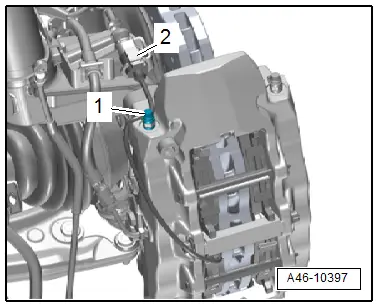
 Note
Note
For easier removal of the brake caliper from the brake rotor, push the brake pads -3 and 4- back lightly with pliers -1-. To prevent damage to the coating on the brake caliper, place a piece of rubber -2- between the pliers and brake caliper.
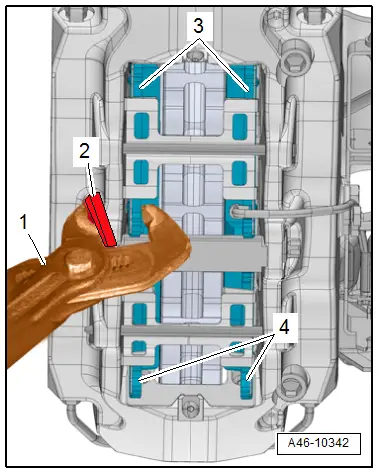
 Note
Note
When removing the brake pad pin, make sure that the brake caliper coating is not damaged.
 WARNING
WARNING
Risk of injury.
The brake pad springs -1 and 5- are tensioned. Press down with hand on the brake pad spring while removing the brake pad pin.
- Drive the brake pad pins -2 and 6- from the outside toward the inside out of the brake caliper all the way and remove the brake pad springs -1 and 5-.

- Remove the brake pads -4 and 7- from the brake caliper.
 Caution
Caution
Danger of damaging the brake caliper piston.
Do not press the brake pedal when the brake pads are removed.
 Note
Note
Ignore item -3-.
Installing
If old brake pads are being replaced with new ones, then it is necessary to check the brake rotor thickness for wear. Pay attention to the wear specifications for the brake rotor.
- Check the brake rotors for wear, refer to → Chapter "Brakes Technical Data".
Install in reverse order of removal. Note the following:
- If the brake pads are being replaced, pay attention to the brake rotor wear limit, refer to → Chapter "Brakes Technical Data".
 Note
Note
- Use the complete repair kit when installing new brake pads.
- Always replace brake pads on both sides of the axle.
 Caution
Caution
Danger of contamination and paint damage from escaping brake fluid.
- If the brake pads are worn out and unnecessary brake fluid is filled, the brake fluid may overflow, causing the pistons in the brake cylinders to be pressed back.
- Check the brake fluid level before pressing back the pistons. If there is brake fluid up to the "MAX" mark, some brake fluid will need to be extracted.
- Use the Brake Charger/Bleeder Unit -VAS5234- to extract brake fluid from brake fluid reservoir.
 Note
Note
- Use only mineral spirits to clean the brake caliper.
- Check the brake piston protective caps for damage and install the complete repair kit, if necessary, refer to → Chapter "Brake Caliper Piston, Removing and Installing, Eight-Piston Brake".
 WARNING
WARNING
Health Risk.
Do not blow out brake system with compressed air.
- Use the Piston Resetting Tool -T10145- to press the brake piston completely into the brake caliper.
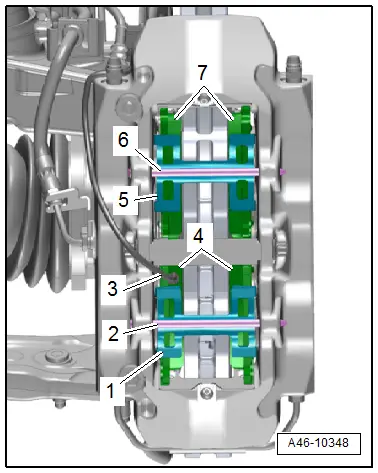
- Clean the brake caliper on the contact surfaces -1, 2 and 3- to the brake pads and the retaining pins -arrows- and thinly coat them with Lithium grease.

- With used brake pads check the wire -3- for the brake pad wear sensor for damage.
 Note
Note
If the brake pad wear sensor is damaged, replace the brake pads.
- Insert brake pads -4 and 7- into the brake caliper.
- The brake pad with brake pad wear sensor is located on the lower left and faces toward the inside of the vehicle.
- Press down the brake pad springs -1 and 5- after one another and drive the brake pad pins -2 and 6- all the way into the brake caliper.
 Note
Note
When driving in the brake pad pins, make sure that the brake caliper coating is not damaged.

- Connect the connector -2- and secure the wire for the brake pad wear sensor with the dust cap -1-.
- Install the front wheel, refer to → Suspension, Wheels, Steering; Rep. Gr.44; Wheels and Tires.
 WARNING
WARNING
Risk of accident!
- Before moving the vehicle, depress brake pedal several times firmly to properly seat brake pads in their normal operating position.
- Make sure the brakes are working correctly before driving the vehicle.
- Check brake fluid level, and fill if necessary.
